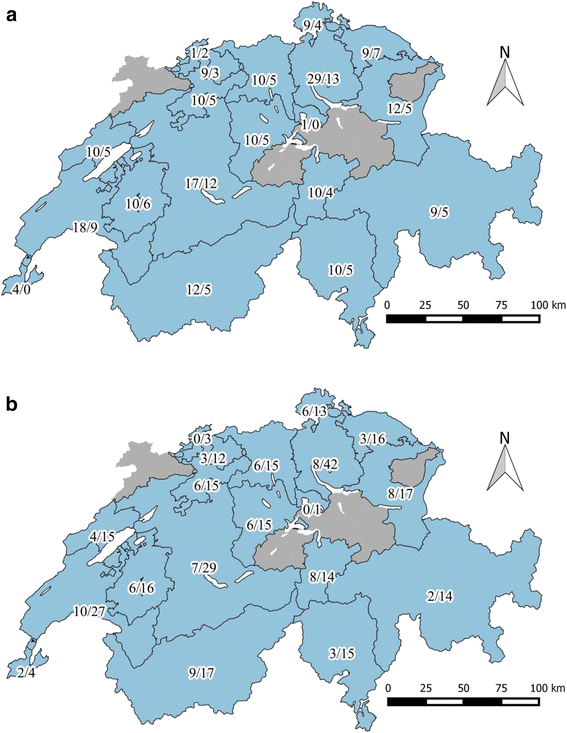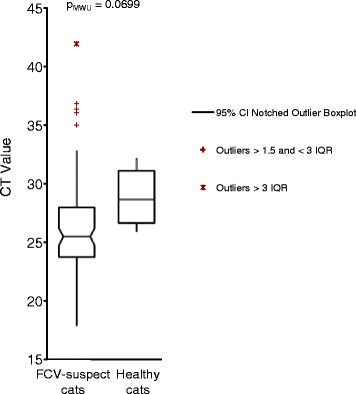Feline calicivirus and other respiratory pathogens in cats with Feline calicivirus-related symptoms and in clinically healthy cats in Switzerland
- PMID: 26566897
- PMCID: PMC4644299
- DOI: 10.1186/s12917-015-0595-2
Feline calicivirus and other respiratory pathogens in cats with Feline calicivirus-related symptoms and in clinically healthy cats in Switzerland
Abstract
Background: Cats with feline calicivirus (FCV)-related symptoms are commonly presented to veterinary practitioners. Various clinical manifestations have been attributed to FCV, i.e. upper respiratory tract disease (URTD), oral ulcerations, gingivostomatitis, limping syndrome and virulent systemic disease. Additionally, healthy cats can shed FCV. The aims of this study were 1) to investigate the frequency of FCV in cats with FCV-related symptoms and in healthy cats in Switzerland, 2) to assess risk and protective factors for infection, such as signalment, housing conditions, vaccination, and co-infection with URTD-associated pathogens, and 3) to address the association between clinical symptoms and FCV infection.
Results: Oropharyngeal, nasal and conjunctival swabs were collected in 24 veterinary practices from 200 FCV-suspect and 100 healthy cats originating from 19 cantons of Switzerland. The samples were tested for FCV using virus isolation and reverse-transcription real-time quantitative polymerase chain reaction (qPCR) and for feline herpesvirus-1 (FHV-1), Mycoplasma felis, Chlamydophila felis, Bordetella bronchiseptica using real-time qPCR. Within the two populations (FCV-suspect/healthy), the observed PCR prevalences were: FCV 45%/8%, FHV-1 20%/9%, C. felis 8%/1%, B. bronchiseptica 4%/2%, M. felis 47%/31% and any co-infections thereof 40%/14%. Based on multivariable regression models amongst FCV-suspect cats (odds ratio [95% confidence interval]), co-infection with M. felis (1.75 [0.97; 3.14]), group housing (2.11 [1.02; 4.34]) and intact reproductive status (1.80 [0.99; 3.28]) were found to be risk factors for FCV infection. In healthy cats, intact reproductive status (22.2 [1.85; 266.7]) and group housing (46.4 [5.70; 377.7]) were found to be associated with FCV infection. Based on an univariable approach, FCV-suspect cats were found to be significantly less often FCV-positive when vaccinated (0.48 [0.24; 0.94]). Oral ulcerations, salivation, gingivitis and stomatitis, but not classical signs of URTD were significantly associated with FCV infection (all p < 0.001).
Conclusions: FCV was detected in less than half of the cats that were judged FCV-suspect by veterinary practitioners. For a clinical diagnosis, FCV-related symptoms should be revisited. FCV infection was present in some healthy cats, underlining the importance of asymptomatic carriers in FCV epidemiology. To reduce FCV-related problems in multi-cat environments, reduction of group size in addition to the generally recommended vaccination are advocated.
Figures


References
-
- Wardley RC, Povey RC. The pathology and sites of persistence associated with three different strains of feline calicivirus. Res Vet Sci. 1977;23(1):15–9. - PubMed
-
- Belgard S, Truyen U, Thibault JC, Sauter-Louis C, Hartmann K. Relevance of feline calicivirus, feline immunodeficiency virus, feline leukemia virus, feline herpesvirus and Bartonella henselae in cats with chronic gingivostomatitis. Berl Munch Tierarztl Wochenschr. 2010;123(9–10):369–76. - PubMed
Publication types
MeSH terms
LinkOut - more resources
Full Text Sources
Other Literature Sources
Miscellaneous

